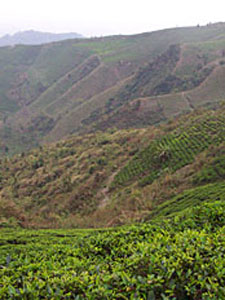Introduction to First Flush Teas



"April is the cruelest month," T.S. Eliot once wrote. But most tea aficionados disagree. This month's weather may get most folks down (or maybe it's simply that they are poetically discontent), but it is a time of celebration in the tea world.
By April, tea plants begin putting forth the first new harvest of the year. After a period of dormancy in winter months, the plants that grow in the more temperate climates once again begin to bud. These "first flush" teas, as they are also known, are renowned for being amazingly fresh and brightly floral. Some of the finest examples of first flush masterpieces come from the famous tea-growing region in Darjeeling, India. In this feature of TeaMuse, I'll provide some of the more salient details to help explain why the first flush (FF) Darjeeling teas are so revered.
First, let's start with the region itself. Darjeeling is a town situated along the slopes of the beautiful Himalayas, 7,000 feet above sea level. The tea plants were first brought to the area from China by the British in the middle of the 19th century. The plants thrived in the rarefied air, the good soil and the plentiful rainfall. The tea estates in Darjeeling are like cities within themselves. A typical garden houses thousands of workers and their families and usually contains hospitals and schools as well as tea manufacturing facilities. Tea is the uniting factor that creates a way of life for these communities.
As spring approaches in Darjeeling, the first light rainshowers hit the plantlife, awakening them from their dormancy. Life begins to appear on the tea bushes and the pickers turn out to harvest the earliest of the leaves and buds. And tea drinkers around the world eagerly wait for their fresh first cup...
The FF tea's unique quality results from the leaf growing in intense sunshine but in the cold, crystalline Himalayan air (called the "Darjeeling Mist") of early spring. These growing conditions make FF Darjeeling a puckery young tea, almost as light as a green tea. But good FF Darjs are distinct from green teas in that they are intensely aromatic. These teas are best steeped using less than boiling water (I set my utiliTEA kettle at 180 degrees) for 3 minutes (like a green tea). A note of caution: these delicate teas can easily be oversteeped.
FF Darjeelings are often compared to also-highly-anticipated Beaujolais Nouveau in the wine world. The Beaujolais Nouveau, which is traditionally first drunk on November 15, is the first toast to the celebrations to come over the impending holiday season. In the case of the FF Darj, April is the season of the first harvest, and is generally the mark of the beginning of a new year of tea. When these teas are brought to the tea markets in Calcutta each year, the best candidates fetch some of the highest prices in the tea world.
And in the Adagio office, there is also a tinge of excitement in the air when April comes around. This is the time when we start receiving boxes upon boxes of small packets from numerous tea estates in Darjeeling, each boasting the best leaves. We then have to systematically categorize, inspect and sample each package that we receive, to pick our first teas of the year. I like to think of it as Tea Christmas: some pleasant packages, many disappointments (I really did like those socks, though, Mom) - but a sure sign that fresh new year is soon to come.
The character and quality of FF Darjeelings vary dramatically over the course of each year (this is why we must request and sample new teas from different estates every year). We have sampled the new Darjeelings, and have chosen a winner. This year's FF Darjeeling is among the best we've ever offered. I encourage all my wonderful readers not to miss out on this year's much-revered First Flush Darjeeling tea.
